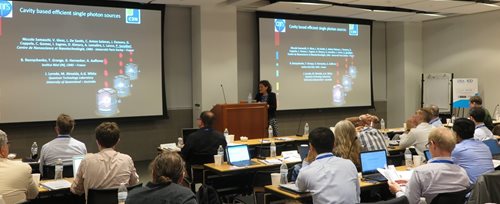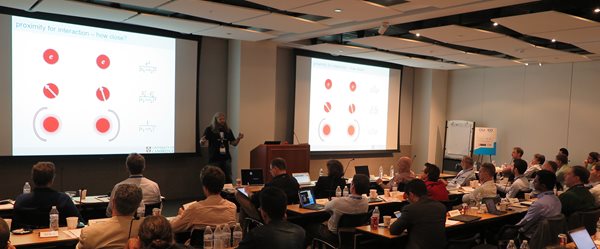Day 1: Integrated Semiconductor Quantum Photonic Devices Incubator
Day 1: Integrated Semiconductor Quantum Photonic Devices Incubator
Michael Forkner, OSA & SPS
Day one of the Integrated Semiconductor Quantum Photonic Devices Incubator focused on Quantum Photonics with Solid-State Photon Sources and Spin Based Quantum Memories. The Incubator, hosted by Daniel Gammon, Naval Research Laboratory; Pascale Senellart, CNRS-Laboratoire de Photonique et Nanost; Glenn Solomon, Joint Quantum Institute/NIST; and Edo Waks, University of Maryland/Joint Quantum Institute, provided the opportunity for invited talks and moderated discussion in order to understand and discuss of the state of research and technology development.
Quantum photonic devices are systems where quantum mechanical interactions dominate and the primary states are photons, or packets of light. Quantum mechanics provides a way to go beyond the classical limit in computers and other devices. It is a realm defined by probability, and understanding and utilizing the probabilistic nature of quantum mechanics can lead to advances in computer systems, cryptography, and electronic systems.
When measuring and producing single photon entanglement, a necessary condition for the types of photonic devices being discussed, two of the biggest challenges are the efficiency at which you can produce an entangled state, and how indistinguishable that state is. Many of the talks ended by discussing their goals for increasing the efficiency or improving the quality of the entanglement.
One of the main points of discussion during the day was the barrier to researchers starting out in the field. Not only is the necessary equipment expensive, but it is also not commercially available. Someone with no connections and no grants would find it very difficult to begin research in quantum photonic devices. This topic evolved into a conversation about why industry should be interested in making these devices for such a small and precise field. Dr. Andrew White, the Director of the Centre for Engineered Quantum Systems, mentioned that people need to let go of the idea of universal quantum computing. Quantum computing does not provide benefits to the everyday user.
Dr. White then took the opportunity to ask the scientists present if it was time for the quantum photonics community to work together on common problems. While all the groups are aware of each other’s research and are collaborating to some extent, there is a difference between sharing results and working together to solve a problem. One of the best things to come out of the discussion was the general acknowledgement that the community should be working together more and communicating their challenges in pioneering a new field.
Stay tuned for more from day 2!
Host Pascale Senellart, CNRS-Laboratoire de Photonique et Nanost, discusses Cavity Based Efficient Single Photon Sources.

Mete Atature, Cambridge University, explores “old friends & new” of Quantum Spin-Photon Interfaces.

